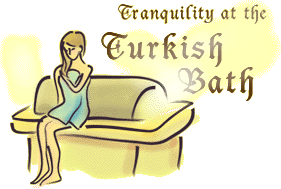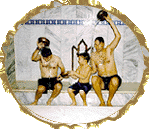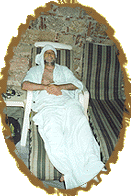 |
 |
 |
|
|||
|
Tranquility at the Turkish Baths Like many Turkish cities, Cekirge is a mix of urban sprawl dotted with remnants of architectural wonders. Surrounding the Old Spa is a nondescript hotel and rows of apartment buildings. But the venerable bathhouse is an oasis of austere beauty. It looks a bit like a mosque, its domed, tiled roofs and the surrounding walls have an aura of serene impregnability, a monument to centuries of tranquility.
Clad only in wooden clogs and a plaid cloth called a pestamal, which wraps around you like a sarong, I give my tokens to an attendant and am instructed to lie down on a deck chair in the resting area. It's all men here; the women's baths are on the other side of the building.
Around the perimeter of the intermediate room are about a dozen marble basins with hot and cold running water, where my trusty guidebook tells me I should soap down and then rinse off with the help of a metal bowl that's been left in the basin. With gestures and sign language and an occasional English word or two, I'm instructed to head over to the main room, which is typically the hottest room in the bathhouse. Now in this particular hammam, the room is certainly high in humidity, but not all that hot in temperature. If you've ever been to a schvitz, like the Russian Baths in New York, that has a lot more firepower. Aah...but what this room has is a deliciously hot mineral water pool, big enough to swim in.
With the help of what feels like a loofah mitt, the attendant soaps and scrapes off several layers of skin. Now while all this soaping is going on -- and indeed the whole time you're in the hamam -- the pestamal stays wrapped around the waist. Modesty is the order of the day. After a thorough rinse, I'm led to a bed-sized marble platform in the center of the massage room. Lying face-down on the slab, I'm soaped down one more time. Then it's over to the basin for a last rinse and yet another massage as I'm dried off, wrapped in towels and shepherded back to the waiting room, looking like one of those guys I saw about an hour ago. From Cekirge, in Turkey, I'm Jim Metzner for The Savvy Traveler.
|
 | American Public Media Home | Search | How to Listen ©2004 American Public Media | Terms of Use | Privacy Policy |

 Entering the hamam is like going back in time. It feels almost like
you're in
a place of worship, standing by a fountain under an huge dome, built with
stone and mortar. This is the entrance hall and resting area.
There are men, swathed in towels, lying down on deck chairs. They look
seriously relaxed. Surrounding this room there are little cubicles where you
change your clothes. I sign up for a rubdown and a massage, which
costs about $20, and am given a few plastic tokens and the key to one of the
little cubicles.
Entering the hamam is like going back in time. It feels almost like
you're in
a place of worship, standing by a fountain under an huge dome, built with
stone and mortar. This is the entrance hall and resting area.
There are men, swathed in towels, lying down on deck chairs. They look
seriously relaxed. Surrounding this room there are little cubicles where you
change your clothes. I sign up for a rubdown and a massage, which
costs about $20, and am given a few plastic tokens and the key to one of the
little cubicles.
 While I'm waiting around, I decide to go in and explore the intermediate room
of the hamam. It's marble, a dome ceiling again, with great acoustics.
While I'm waiting around, I decide to go in and explore the intermediate room
of the hamam. It's marble, a dome ceiling again, with great acoustics.
 A few laps in this huge marble bathtub, and I'm ready for the the massage
room. The massage room is also surrounded by marble basins, and it's while
sitting next to one of these that an attendant begins to rub me down.
A few laps in this huge marble bathtub, and I'm ready for the the massage
room. The massage room is also surrounded by marble basins, and it's while
sitting next to one of these that an attendant begins to rub me down.